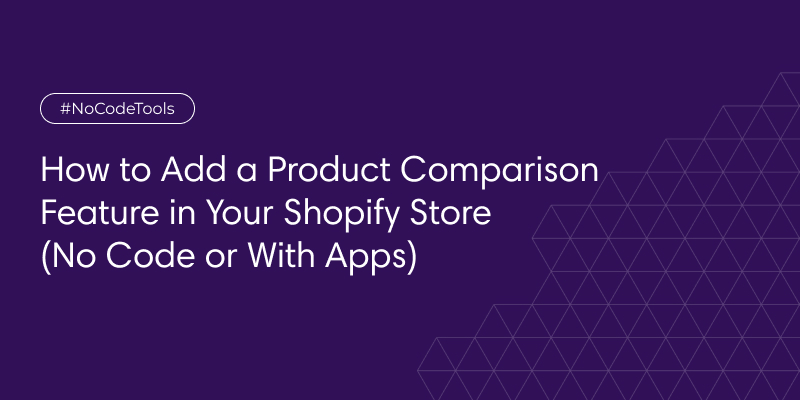Table of Contents
- Why Product Comparisons Improve Conversions
- Methods to Add Product Comparison in Shopify
- Using Shopify Apps such as Compare Products by Omega
- Custom Code Option via Liquid and JavaScript
- Best Practices for Effective Comparison Tables
- UX Tips for Comparison on Mobile
- Recommended Apps with Pros, Cons
- Comparely, Product Compare by Omega, etc.
- Final Thoughts and Conversion Tips
- FAQs
Adding a product comparison option can give your store a tangible conversion boost by helping visitors make quicker, more informed decisions. In this post we explore both app‑based and code‑based ways to implement a Shopify product comparison feature along with proven design and UX principles.
Looking to scale even further? Check out this guide to explosive Shopify growth apps:
Top 10 Shopify Apps for Explosive Growth in 2025
1. Why Product Comparisons Improve Conversions
A comparison feature helps reduce decision fatigue, clarify feature differences, and highlight value propositions side by side. When customers can see product specs, price differences, and benefits in a clear table, comparison triggers become buying triggers.
Real benefits include:
- Lower bounce rates
- Higher average order value
- Better retention through clearer product matching
2. Methods to Add Product Comparison in Shopify
Using Shopify Apps such as Compare Products by Omega
Apps like Comparely, Product Compare by Omega, and others enable quick installation with ready comparison buttons, customizable tables, and automatic syncing with product data.
Custom Code Option via Liquid and JavaScript
If you prefer a lean, lightweight option, you can manually build comparison functionality using Liquid templates and JavaScript:
- Create a snippet for a “Compare” checkbox or button
- Use JavaScript to store selections in localStorage
- Render a dynamic comparison table on a separate page or modal that pulls product metafields
This requires technical work but avoids recurring app costs and keeps performance tight.
3. Best Practices for Effective Comparison Tables
An effective comparison table should be scannable and helpful. Keep these best practices in mind:
- Use consistent attribute headings (native features, price, dimensions, warranty)
- Highlight differences visually (bold or color)
- Limit the number of columns (max 3‑4 products at once)
- Provide a clear CTA underneath the table, such as “Buy Now” or “View on Shopify”
Avoid clutter and show only meaningful, user‑relevant data.
4. UX Tips for Comparison on Mobile
Designing for mobile is critical when using a Shopify product comparison tool:
- Use a horizontal scroll or accordion format
- Keep table elements simple and responsive
- Provide collapse and expand options
- Use sticky compare button or CTA at bottom of mobile viewport
Ensuring mobile usability dramatically improves engagement and reduces drop off on comparison pages.
5. Recommended Apps with Pros, Cons
The table below highlights popular app options so you can compare and choose based on your needs:
| App Name | Pros | Cons |
| Comparely | Fully featured, customizable layout, Shopify Plus support | Monthly fee after free tier, some features advanced only |
| Product Compare by Omega | Lightweight, easy to install, no coding required | Basic UI, fewer customization options |
| Product Compare Pro | Good performance, demo switching, auto updates | Can affect page speed if overloaded with products |
6. Final Thoughts and Conversion Tips
Adding a comparison feature is not just a nice‑to‑have; it can be a powerful differentiator for your Shopify compare products app strategy. Whether installed via app or built with code, make sure your comparison tool is intuitive, mobile‑friendly, and focused on the buyer’s journey.
Conversion tips:
- Integrate product reviews or ratings into the comparison view
- Use trust badges under CTA buttons to reinforce credibility
- Offer comparison-based discounts (e.g., “Buy 2 for 10% off”)
- Track click behavior and user flow in Analytics to optimize the experience
7. FAQs
Q1, What is a Shopify product comparison feature?
A, It’s a function that allows users to compare multiple products side by side using tables to highlight differences in specs, price, reviews and features.
Q2, Do I need coding knowledge to add product comparison in Shopify?
A, No, apps like Comparely or Omega make it easy with no code options. You can opt for custom code if you need full control.
Q3, Will comparison tables affect site performance?
A, Using a lightweight app or well‑written Liquid code minimizes performance impact. Avoid overly large tables with too many columns.
Q4, How many products should I allow for comparison?
A, Ideally 3‑4 to keep layouts clean and easy to digest, especially on mobile devices.
Q5, Should I include comparison after first order?
A, Yes, offering comparison tools in post‑purchase emails or pages encourages upsells and cross‑sells.

Ecommerce Root is one of the leading ecommerce guide which provides total solutions for ecommerce.









Leave a Reply